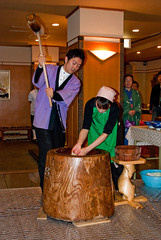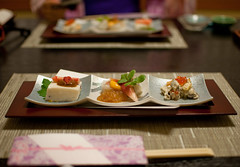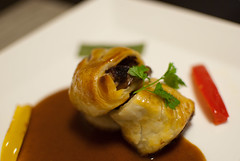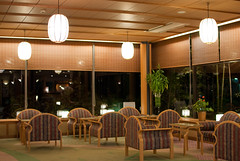Hi, H writing here.
Welcome to N and H's travel blog of our recent 12-day trip to the Kansai region of Japan. If you have not heard about the Kansai region of Japan, then you're missing out. Kansai is an area in West Japan that is centred around the city of Osaka. It also includes the ancient Japanese capitals of Nara and Kyoto. So there is a lot of history in this area of Japan. Osaka is also famous for its variety of different food. So Kansai is a very exciting destination for history buffs and food buffs alike.
We had a lot of work to do before flying off on our vacation. N did the majority of the research and bookings because we used mostly Chinese and Japanese resources to plan our trip. So all the kudos have to go to her for the planning.
We love flying Japan Airlines when going to Japan and sought out a travel agency that works with JAL. We found a Vancouver-Osaka package at
Silkway Travel for about C$989. After all the extra charges and tax, the final cost was roughly C$1,100 per person for round-trip airfare and 3 nights hotel in Osaka.
However, after our last trip in 2006 to Tokyo, we knew that 3 nights and 4 days would not be enough to experience Japan. So we decided to tack on a lot more days. That way, we would be able to enjoy Japan on our terms and at our pace.
We definitely avoided signing up for any tours. We don't like being herded around from site to site at the direction of a guide. We purchased a few books to help us on our travels. Three of the books were in Traditional Chinese. There was one book that we relied on the most. It's this pink one shown below.

Sky Publishing HK(Chang Kong Chu Ban) is a popular publisher of trip guides for those who read Traditional Chinese. The back of the book comes with many testimonies of Hong Kong celebrities. The one above is actually newer than the copy we had. We had the 08-09 edition. There is a newer one available from
YesAsia.com that is the 09-10 edition, or you could buy it at the Kinokuniya Bookstore in Seattle like we did. The Chinese language travel books tend to be more focused on playing, eating and shopping. Major historic sites are always mentioned, but some of the lesser known sights and museums are often left out. One great thing about the Chinese travel books, though, is that they have tons of pictures in tons of colour. You just have to know how to read it. N is fluent in Chinese and I can read all the location names quite easily. What's harder for me is reading the descriptions. I can slog through some of it, but I don't understand everything.
I don't read Chinese as well as English and I wanted to have more a list of historic sites and museums, so I bought a couple of books myself.
Lonely Planet publishes tons of travel guides and thankfully, they had a Kyoto City Guide. Unfortunately, the only other Japanese City Guide from Lonely Planet is Tokyo. The Kyoto City Guide is almost strictly focused on Kyoto and its neighbourhoods. Osaka and some of the neighbouring cities are mentioned in a handful of pages and lacks detail about those places. There are very few colour pictures, but has a more extensive listing of historic sites and museums that would interest travellers from Western countries more. One huge limitation of the Lonely Planet guide, though, is that they did not print the Japanese names along with the English place names except on the map legends. So I had to keep flipping through the pages to match up the Japanese and English names.

I also got another book from
Sophia Books on West Hastings (Sophia Books specializes in foreign language books).
Kyoto: Introduced in English & Japanese is a bilingual book printed in Japan, so it was an expensive purchase. As a travel book, it's not all that useful. However, it was good for reading up more on the cultural aspects of Kyoto including the difference between the shrines and temples. It was all in brilliant colour, but perhaps it would have been better if I could have borrowed it from the library instead. Out of all the books we had, I must say like the maps in this one the best. Probably because the maps were bilingual in English and Japanese. Some times I find it easier to know the Kanji name of a place. Places often only display their names in Japanese and not English.

We also had to find extra accommodation above and beyond the 3 nights packaged with our airfare. My wife discovered the Japanese version of hotels.com,
Jalan.net, through Chinese travel blogs. Jalan.net assumes you know a lot of Japanese. My wife has been learning Japanese, so she ventured on the site and found rooms at a central hotel for 7,300 Yen a night. That's about C$80 a night. When I checked hotel.com and other travel sites, the same hotel room was going for over US$100 a night. So
Jalan.net was great, but only because N managed to understand most of the Japanese on the site.
Just before flying off, I also came across a English version of Jalan.net.
Japanican.com is all English and would have been easier for me to book a hotel room if needed. But since everything was already set by the time I found the site, I did not find use for it.
So we had our air tickets and our rooms all set. We just had to figure out how to get around. That was easier said than done, but N did a great job figuring out how to maximize the special tourist passes in Kansai.
to be continued...







































